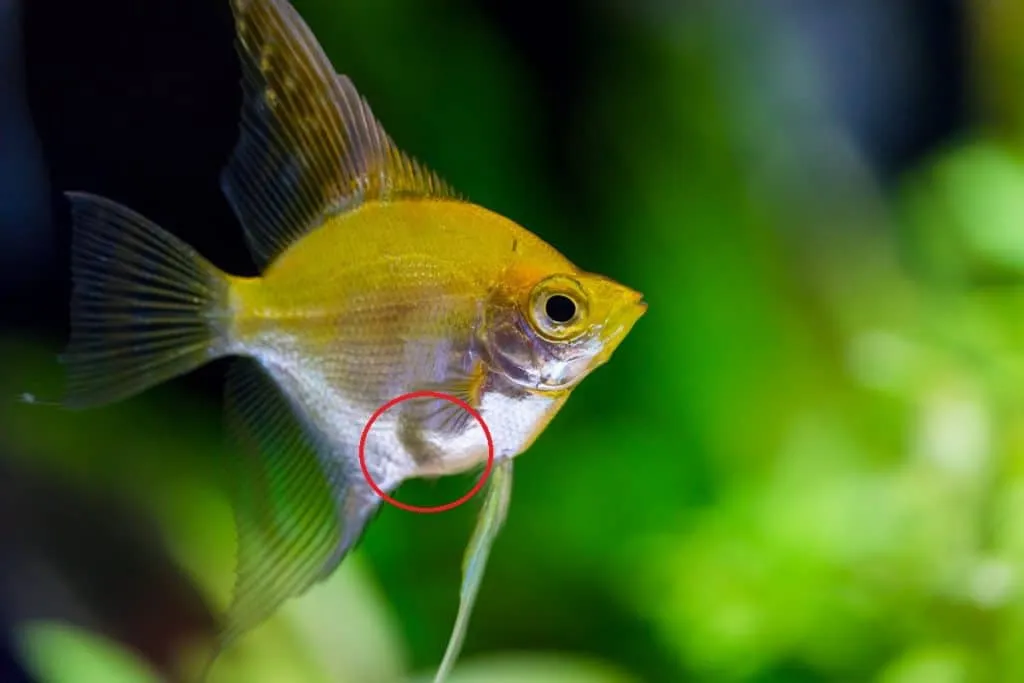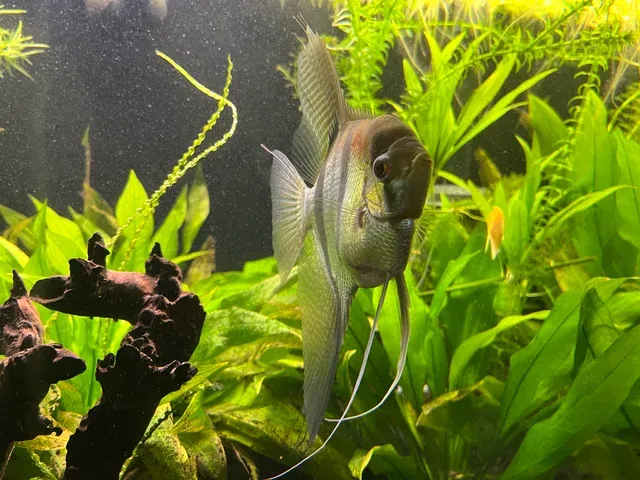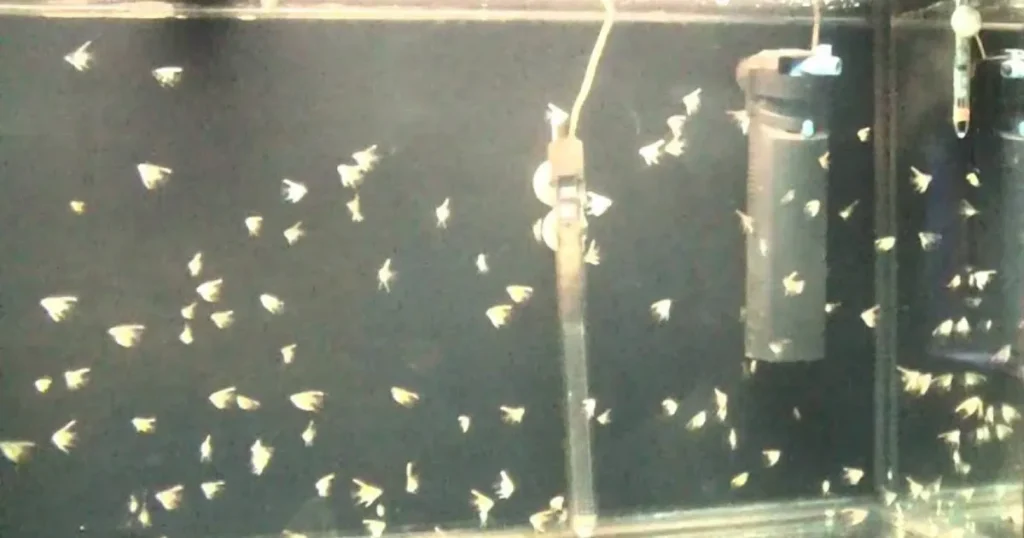The sight of a swelling angelfish abdomen often triggers the question – could be my angelfish pregnant? Identifying a gravid (pregnant) female angelfish is important for aquarists looking to breed these beautiful fish. It alerts you to provide ideal tank conditions and prepare for impending fry.
In this article, we’ll guide you through the distinct signs of a female pregnant angelfish. You’ll learn to recognize physical symptoms, behavioral changes, and preparations needed for expecting angelfish mothers. Let’s get started!
Understanding Angelfish Pregnancy.

First, a quick primer on angelfish reproduction. Angelfish do not get “pregnant” in the traditional sense, since females lay eggs rather than giving live birth.
The male angelfish fertilizes the eggs as the female lays them. The female then solely cares for the eggs, protecting and fanning them until they hatch. So the term “pregnant” refers to the female angelfish carrying a clutch of developing eggs.
Identifying this gravid state is the first step towards breeding success. An observant aquarist can recognize several tells that signal an expecting angelfish mom-to-be.
How to Tell if an Angelfish is Pregnant?
Physical Signs of a Female Pregnant Angelfish.
A pregnant angelfish will demonstrate some distinct physical changes as eggs develop internally:
A Dark Gravid Spot

- The most prominent sign is a dark gravid spot on the abdomen. This is where eggs are stored before laying.
- The black dot grows larger and more intense as eggs mature. It may span the width of the abdomen when full of eggs.
A Swollen Belly

- The female’s belly will swell dramatically in the final days before spawning, almost appearing box-shaped.
- If viewed head-on, a thickened torso filled with eggs is visible behind the pectoral fins.
Prominent Ovipositor Tube
- The ovipositor tube near the anal fin becomes more pronounced and whitish-pink.
- This tube will expel the eggs during spawning and is a clear pregnancy indicator.
Changes in Appetite
- Pregnant females often eat less in the final days before spawning, as eggs take up abdominal space.
- But some continue feeding normally. So lack of appetite alone is not a foolproof sign.
With an observant eye, these distinctive physical changes betray the presence of developing eggs in a female angelfish. But behavior also provides important clues.
Pregnant Angelfish Behavior.
Along with physical symptoms, pregnant angelfish display changed behaviors leading up to spawning:
Increased Aggression
- Angelfish generally become more aggressive while breeding to protect their territory.
- But pregnant females may show heightened aggression toward tankmates several days before spawning. They instinctively protect their eggs-to-be.
Choosiness About Mate
- A gravid female may respond aggressively to the male’s courtship advances at first. She becomes extremely picky about selecting the right partner.
- Once she accepts the male, the pair establishes a bond, signaling imminent spawning.
Seeking Out Spawning Sites
- A pregnant female spends more time surveying surfaces suitable for attaching eggs, like leaves and aquarium glass.
- She may pointedly clean a specific site by fanning it vigorously, and readying it for egg deposition.
Lethargy and Reclusiveness
- Late in pregnancy, the heavyweight of eggs makes females more lethargic. They retreat to hideouts, emerging only to eat or interact with the male.
- This reclusive behavior protects her vulnerable abdomen filled with eggs.
So behavioral shifts coupled with physical changes clearly indicate an expecting angelfish mother. Let’s look closer at characteristic pregnancy symptoms next.
Common Angelfish Pregnant Symptoms.
Here are some of the most common bodily changes and behaviors exhibited by pregnant angelfish:

Increased Aggression
- Pregnant females zealously defend their territory and eggs-to-be from intruders. They may even nip tankmates that stray too close.
- Target tank aggression toward the male mate, establishing dominance in the pairing.
Loss of Appetite
- In the last 1-2 days before spawning, females eat sporadically or refuse food entirely. The eggs occupy all available abdominal space.
- But some pregnant females continue eating normally right until spawning. So lack of appetite alone doesn’t confirm pregnancy.
Restlessness
- Females may swim erratically or shimmy against objects as hormones fluctuate prior to breeding. This signals eggs are nearing maturity.
Reclusive Behavior
- A pregnant female seeks isolation from tankmates, hiding amongst plants and decorating to protect her egg-laden abdomen.
- She may allow only the male to approach and initiate courtship rituals.
Watch for a combination of these symptoms to positively identify an expecting angelfish mom!
Preparing for Angelfish Pregnancy and Fry.
Once you confirm your female angelfish is pregnant, preparation ensures you give eggs and fry the best chance of survival:

Condition Fish With High-Protein Food
- Feed high-quality protein like frozen or freeze-dried brine shrimp, mysis, bloodworms. This helps develop strong, viable eggs.
- Offer small, frequent meals 3-4 times daily in the weeks before breeding.
Move Parents to Spawning Tank
- Set up a dedicated 10-20 gallon breeding tank with spawning sites. Keep water pristine.
- Move the bonded pair here 1-2 days before eggs are expected. Limit stress.
Add Spawning Surfaces
- Vertically submerge a smooth slate, rock, or driftwood for attaching eggs.
- Plants like Java fern also work. Ensure surfaces are clean and stable.
With some planning and preparation, you’ll be ready to welcome the next generation of angelfish to your tank!
Caring for Pregnant Angelfish.
Providing good care in the final days before spawning helps pregnant angelfish positively. Here are some tips:
Maintain Pristine Water Quality
- Monitor parameters daily. Promptly remove any waste, leftover food.
- Perform 10-15% water changes twice weekly to dilute metabolites.
Provide Security
- Give plenty of hiding places like plants and caves. Isolation reduces stress.
- Limit tank activity and disruptions to lower stress.
Prioritize A Healthy Diet
- Feed 2-3 small, high-protein meals per day. Freeze-dried krill and brine shrimp are excellent.
- Ensure the female is actually eating to nourish her eggs.
With attentive, low-stress care, you give pregnant angelfish and their eggs the best odds of healthy development.
FAQs about Angelfish Pregnancy.
To wrap up, let’s address some common questions about angelfish reproduction and pregnancy:
How Often Do Angelfish Breed?
Under ideal conditions, angelfish can spawn every 2-3 weeks. Females continuously produce new batches of eggs. Provide a strong breeding pair with high-protein foods to promote regular spawning cycles.
How to Tell a Male vs Female Angelfish?
Males have a distinct nuchal hump on the forehead. Females lack this hump and have a rounder, fuller body shape. Females also display spawning tube protrusion when gravid. Mature males develop longer ventral fins.
When to Move Parents Before Fry Hatch?
Move the parents back to the main tank just after spawning completes. Their work is done! Leaving parents inside risks them eating newly hatched fry once their protective parental instincts wane.
Can You Leave Angels with Fry?
Some angel pairs make excellent parents and will not harm fry. But this is unpredictable. Unless you have bred the pair before, it is safest to remove adults right after spawning.
How long are angelfish pregnant before laying eggs?
Angelfish carry eggs internally for 2-3 days before laying. Eggs fully develop within 36-48 hours of the female accepting a mate. Watch for birthing signs like isolation and abdominal swelling as eggs near maturity.
How do you know if your angelfish is pregnant?
Look for a swollen abdomen, darkened gravid spot, prominent ovipositor tube, increased aggression, and reclusive behavior. Combinations of physical and behavioral changes will confirm pregnancy versus just bloating or overfeeding.
What does a pregnant angelfish look like?
A pregnant angelfish will have a distinctly swollen or lopsided belly, with the abdomen protruding out behind the pectoral fins. The gravid spot darkens to black and expands on the mid-abdomen. The ovipositor tube near the anal fin whitens and lengthens as eggs mature for laying.
Do pregnant angelfish eat their eggs?
No, female angelfish instinctively protect fertilized eggs until they hatch. They will fan and guard the eggs tirelessly. Though angelfish may eat their own eggs if they are infertile or the environment makes them feel unsafe to breed.
Can you tell if angelfish eggs are fertilized?
Fertilized angelfish eggs look clear and round while infertile eggs appear cloudy/fungal. Parents will also carefully tend fertile eggs while ignoring bad ones. Candling eggs in front of a light also reveals embryo development in fertile eggs.
How do you take care of pregnant angelfish?
Give pregnant angelfish optimal conditions like clean water, high-protein foods, dim lighting, and isolation from tankmates. Maintain stable water parameters and temperature. Provide ample hiding places and gentle filtration. Minimize external stressors to encourage spawning.
Conclusion.
Identifying pregnancy signs allows angelfish keepers to prepare for breeding success. An observant aquarist can spot several symptomatic changes in a gravid female’s appearance and behavior. Recognizing these transformations alerts you to optimize tank conditions and stand ready to welcome the next generation!
We hope this guide helps you positively identify when your female angelfish is expecting. With some attentive care, you can give mom and eggs the best shot at producing healthy fry. Best of luck with your angelfish breeding endeavors! Please share your experiences with us.
Slug: is-my-angelfish-pregnant
Meta Description: Learn how to identify a pregnant female angelfish through distinct physical symptoms and behavioral changes. Spot the signs of impending spawning to prepare your tank for angelfish breeding success!
